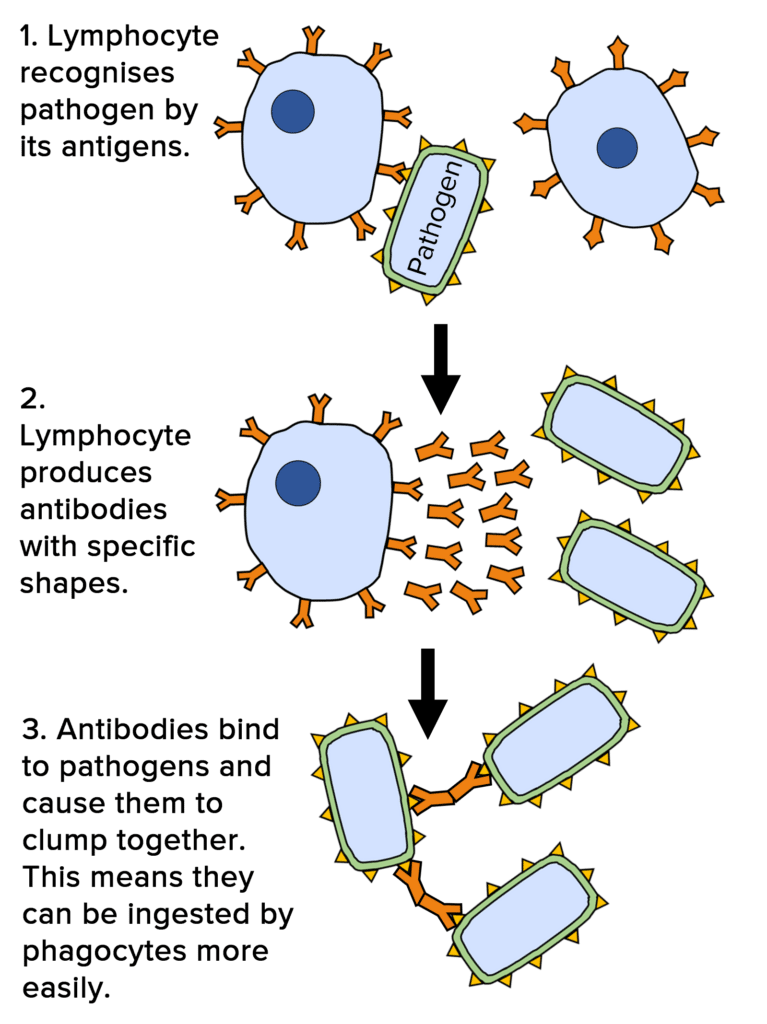Human Defence Systems
Human Defence Systems Revision
Human Defence Systems
The human body defends itself against pathogens using various non-specific defence systems and the immune system. The white blood cells in the immune system detect and destroy pathogens as quickly as possible before they have chance to reproduce and cause serious infections.
Non-specific Defence
Non-specific defence systems are those that defend the body against all pathogens, usually by preventing them entering the body.
- Skin covers the majority of the body and acts as a physical barrier to pathogens trying to get in. If a person is wounded and the skin is broken, platelets begin to gather at the site of the wound and a scab forms to maintain the physical barrier.
- The nose has hairs and mucus that act as a physical barrier and trap any pathogens that try to enter from the air. The pathogens are removed from the body when a person sneezes or blows their nose.
- The trachea and bronchi have goblet cells that produce mucus that traps pathogens (physical barrier). They are also lined with ciliated cells that have tiny hairs called cilia. The cilia waft the mucus and pathogen upwards to the throat so it can be swallowed and sent to the stomach.
- The stomach contains acid that acts a a chemical barrier. Pathogens enter the stomach in food or in mucus from the trachea and bronchi and get killed by the highly acidic stomach acid (hydrochloric acid).
Immune System Response
The immune system detects and kills pathogens that have made it past the non-specific defences. Phagocytes and lymphocytes are types of white blood cell and are responsible for the immune response:
- Phagocytes:
Phagocytosis is the non-specific process by which phagocytes engulf and digest pathogens and is sometimes aided by lymphocytes. Lymphocytes produce antibodies that cause the pathogens to clump together making them easier to engulf.


- Lymphocytes:
Pathogens have specific molecules called antigens on their surface that allow them to be detected by lymphocytes. Lymphocytes then produce antibodies with specific shapes that enable them to bind to the antigens on the pathogen. Binding of the antibodies cause the pathogens to clump together making them easier to be ingested by phagocytes.
Memory cells are lymphocytes that remain in the blood after an infection. If the individual is infected with the same pathogen in the future, the memory cells quickly produce the antibodies to help destroy the pathogen before it reproduces and starts causing cell damage and symptoms.
Lymphocytes also may produce antitoxins that neutralise toxic substances produced by the pathogen. This can prevent cell and tissue damage and therefore stop the infected individual experiencing symptoms and feeling unwell.
Human Defence Systems Example Questions
Question 1: Explain the mechanisms that stop pathogens entering the body via the trachea and bronchi.
[3 marks]
- Mucus traps pathogens.
- Cilia waft mucus and pathogens up to the throat.
- Mucus and pathogens get swallowed and destroyed by the stomach acid.
Question 2: Explain how lymphocytes aid phagocytosis.
[3 marks]
Lymphocytes produce antibodies that bind to antigens on the pathogen.
This makes them clump together.
Phagocytes can more easily engulf and digest pathogens.
Question 3: What is the purpose of antitoxins?
[2 marks]
Antitoxins neutralise toxins produced by pathogens.
Prevents toxins damaging cells and therefore prevents symptoms / illness.






